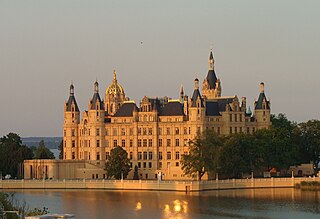
Schwerin is the capital and second-largest city of the northeastern German state of Mecklenburg-Vorpommern as well as of the region of Mecklenburg, after Rostock. It has around 96,000 inhabitants, and is thus the least populous of all German state capitals.

Ludwigslust is a central castle town of Mecklenburg-Vorpommern, Germany, 40 km south of Schwerin. Since 2011 it has been part of the Ludwigslust-Parchim district.

Wanderer was a German manufacturer of bicycles, motorcycles, automobiles, vans and other machinery. Established as Winklhofer & Jaenicke in 1896 by Johann Baptist Winklhofer and Richard Adolf Jaenicke, the company used the Wanderer brand name from 1911, making civilian automobiles until 1941 and military vehicles until 1945.

Hagenow is a German town in the southwest of Mecklenburg-Western Pomerania, in the district of Ludwigslust-Parchim, 30 kilometers south of Schwerin. Its population is approximately 11,300 inhabitants (2013).
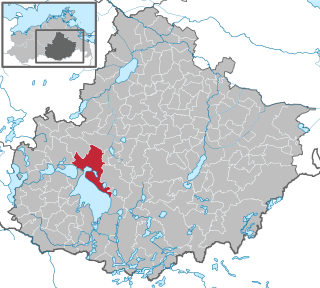
Waren (Müritz) is a town and climatic spa in the state of Mecklenburg-Vorpommern, Germany. It was the capital of the former district of Müritz until the district reform of 2011. It is situated at the northern end of Lake Müritz, approximately 40 kilometres west of Neubrandenburg. Waren is home to the offices of the sub-district (Amt) of Seenlandschaft Waren, although the town itself is independent of any Amt. Its borough is the second largest in Mecklenburg-Vorpommern by area.

Boizenburg is a municipality in the Ludwigslust-Parchim district in Mecklenburg-Western Pomerania, Germany. It is situated on the right bank of the Elbe, 53 km west of Ludwigslust, 25 km northeast of Lüneburg and 50 km east of Hamburg. It is part of the Hamburg Metropolitan Region. Boizenburg's historical old town stretches along the Elbe, has a harbour and offers heritage baroque timberframe and brick buildings.

Fürstenberg is a town in the Oberhavel district, Brandenburg, Germany.

Lübz is a town in the Ludwigslust-Parchim district, in Mecklenburg-Western Pomerania, in north-eastern Germany. It is situated on the river Elde, 12 kilometres (7.5 mi) northeast of Parchim.

Plau am See is a town in the Ludwigslust-Parchim district, in Mecklenburg-Western Pomerania, in north-eastern Germany. It is situated 28 kilometres (17 mi) east of Parchim, and 29 kilometres (18 mi) west of Waren.

Stavenhagen is a municipality in the Mecklenburgische Seenplatte district, in Mecklenburg-Vorpommern, Germany. It is situated 28 km northwest of Neubrandenburg.
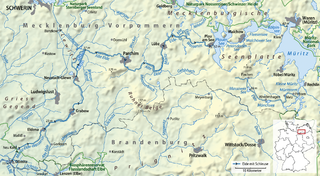
The Elde is a river in northern Germany, a right tributary of the Elbe. Its total length is 220 kilometres (140 mi). The Elde originates near Altenhof, south of Malchow. It first flows southeast towards the southern end of Lake Müritz, which it enters at Vipperow. It flows out of the Müritz at its northern end, near Waren. It turns west, and flows through a series of small lakes, and along the town of Malchow, until the Plauer See. It flows out of the Plauer See at Plau am See, and continues west and southwest through Lübz, Parchim, Neustadt-Glewe, Grabow and Eldena, and flows into the Elbe at Dömitz. Near Eldena, the Alte Elde branches off and flows into the Löcknitz near Eldenburg, part of Lenzen (Elbe). For much of its length, 180 kilometres (110 mi), it forms the navigable Müritz-Elde-Wasserstraße, with 17 locks. The Elde is murky, due to the fast erosion of the valley around it.
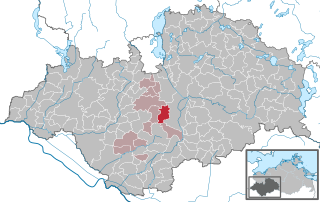
Wöbbelin is a municipality in the Ludwigslust-Parchim district in Mecklenburg-Vorpommern, Germany. The municipality has a seat in the office of Ludwigslust from where it is administered. Wöbbelin consists of three areas: Dreenkrögen, the "Funkamtsiedlung", a housing development and buildings supporting a former radio broadcasting station, and the main town, Wöbbelin.

Rom is a municipality in the Ludwigslust-Parchim district, in Mecklenburg-Vorpommern, Germany.
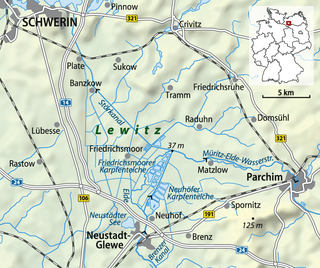
The Lewitz is a protected landscape in the German state of Mecklenburg-Vorpommern, a land of broad, flat pastures and farmland, fish ponds and occasional woodlands.
Alte Burg, Alteburg or Burgstall Alte Burg refers to the name or nickname of various castles, castle ruins, castle sites and hillforts or ringworks:

The Lordship of Parchim-Richenberg was a short-lived state of the Holy Roman Empire which existed during the 13th century. It arose from the first partition of Mecklenburg after the death of Henry Borwin II, Lord of Mecklenburg in 1226. Initially it was named after its capital Parchim. Later, following the transferral of the seat to Richenberg, the name shifted to Richenberg. The Lordship comprised the lands of Parchim, the rural area of Ture and the later Vogteis of Plau, Goldberg, Sternberg and finally Richenberg. It was the shortest-lived of the four partitioned principalities of Mecklenburg.
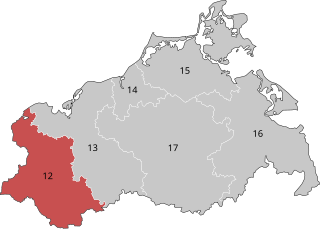
Schwerin – Ludwigslust-Parchim I – Nordwestmecklenburg I is an electoral constituency represented in the Bundestag. It elects one member via first-past-the-post voting. Under the current constituency numbering system, it is designated as constituency 12. It is located in western Mecklenburg-Vorpommern, comprising the city of Schwerin and western parts of the districts of Ludwigslust-Parchim and Nordwestmecklenburg.
Garwitz is a district of the municipality of Lewitzrand in the Ludwigslust-Parchim district in Mecklenburg-Vorpommern, Germany.























